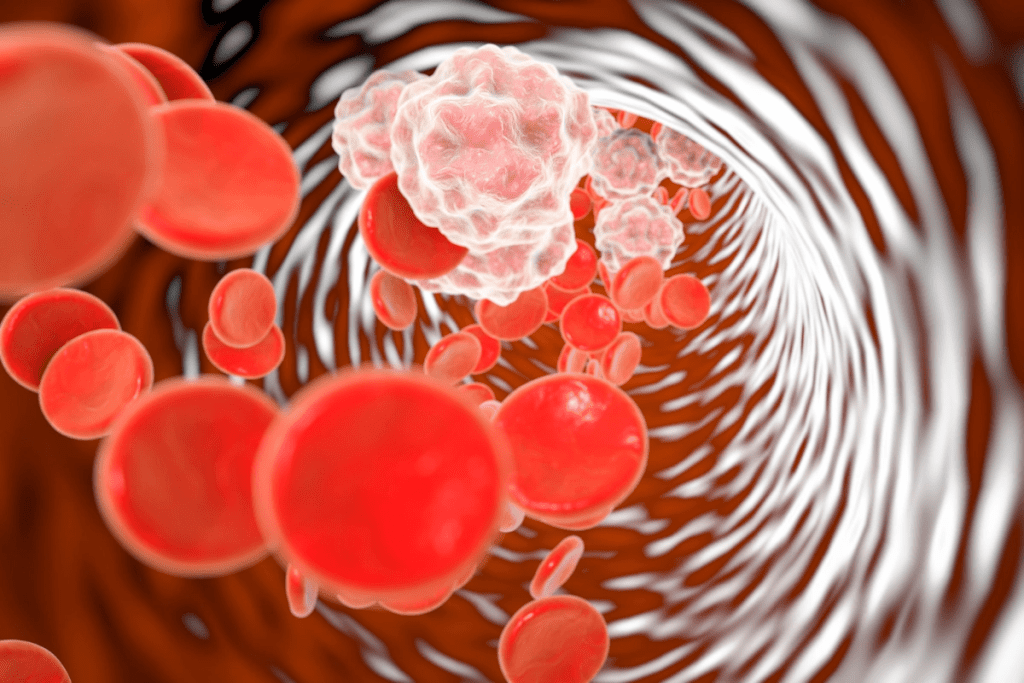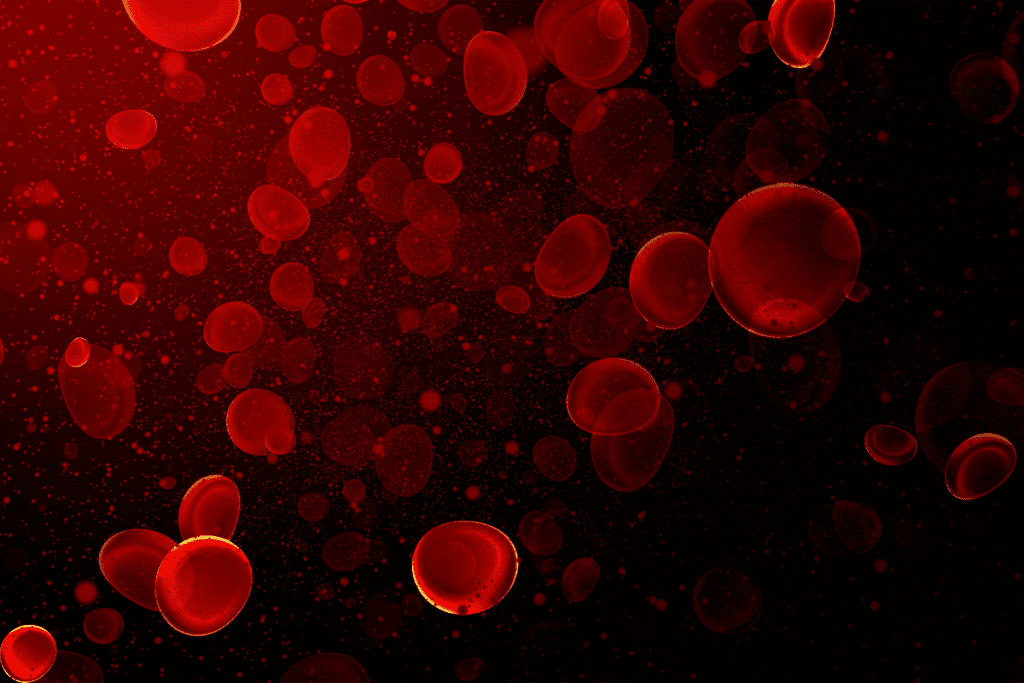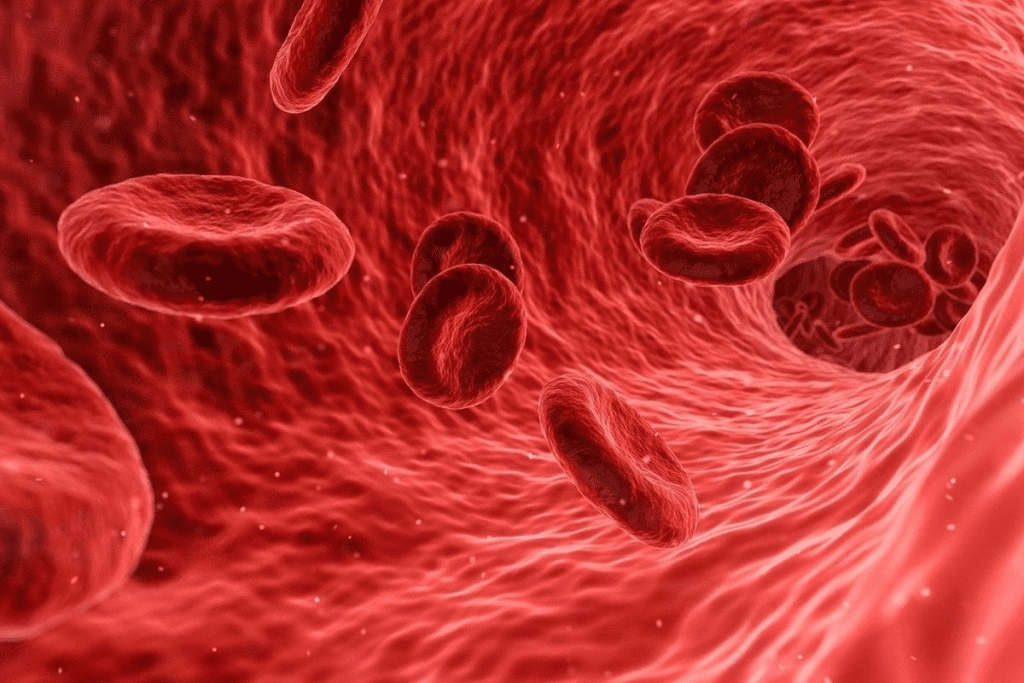Last Updated on October 21, 2025 by mcelik

Did you know that nearly one in four people worldwide suffer from a lack of red blood cells or hemoglobin in the blood? This condition, often leading to fatigue, weakness, and other debilitating effects, is a significant health concern globally.
We know that a lack of red blood cells can really affect someone’s life. This condition, known for causing a range of symptoms due to insufficient hemoglobin, is a critical health issue that affects millions. By understanding what it means to have a low red blood cell count, we can better grasp the importance of addressing this condition.

Red blood cells, or erythrocytes, are key for carrying oxygen around our body. They are vital for our circulatory system. These cells help move oxygen from the lungs to our tissues and organs.
Red blood cells have hemoglobin, a protein that holds onto oxygen. This is how they transport it to all parts of our body. Without enough red blood cells or working hemoglobin, our body’s tissues and organs might not get enough oxygen.
Red blood cells are made in the bone marrow through a process called erythropoiesis. On average, a red blood cell lives for about 120 days. Our body keeps making new red blood cells to replace old or damaged ones.
This balance is key for our health. Problems with red blood cell production or lifespan can cause anemia. Anemia is when we have too few red blood cells or they don’t work right.

Anemia is when your body has too few red blood cells or they don’t carry enough oxygen. This is because they lack hemoglobin, a key protein.
Anemia isn’t a disease but a sign of something else. It can be caused by iron deficiency, vitamin deficiency, chronic diseases, or genetic disorders. It happens when your body can’t make enough red blood cells or they get destroyed too fast.
Understanding anemia is key to treating it. It’s about finding out why it’s happening. This could be because of what you eat, a long-term illness, or your genes.
“Anemia is a sign of an underlying problem, not a diagnosis in itself. Identifying the root cause is critical for effective management.”
Anemia affects many parts of your body. It can make you feel tired, weak, and short of breath. Your heart also has to work harder because of the lack of oxygen.
| Body System | Effects of Anemia |
| Cardiovascular | Increased heart rate, palpitations, potentially leading to heart failure in severe cases |
| Respiratory | Shortness of breath, even at rest in severe anemia |
| Musculoskeletal | Fatigue, weakness, reduced endurance |
Anemia can also hurt your brain, making it hard to focus and remember things. It weakens your immune system, making you more likely to get sick.
Healthcare providers can create better treatment plans by knowing how anemia affects your body. They can tackle the root cause and help with the wide-ranging effects.
Anemia can make you feel tired and weak. It also causes pale skin and shortness of breath. These symptoms can be a sign that your body needs more iron or vitamins.
Women often notice these signs more than men. This is because women lose iron during their periods. If you’re feeling tired or weak, it’s important to talk to a doctor.
They can check your blood and find out if you have anemia. They can then suggest the right treatment for you.
It’s key to listen to your body and seek help if you notice any unusual signs. Early treatment can help you feel better and prevent more serious problems.
It’s important to understand how to diagnose low red blood cell count. Doctors use blood tests to check the red blood cell count and other factors. This helps them find the right treatment.
A Complete Blood Count (CBC) test is often the first step. It looks at several parts of the blood, including:
CBC testing gives a detailed look at the blood’s cells. It helps doctors spot any issues with red blood cells.
Hemoglobin and hematocrit are key to checking red blood cell health. Hemoglobin carries oxygen, and hematocrit shows the red blood cell amount in the blood.
| Parameter | Normal Range | Indications of Low Value |
| Hemoglobin (g/dL) | 13.8-17.2 (men), 12.1-15.1 (women) | Anemia, blood loss, or chronic disease |
| Hematocrit (%) | 40.7-50.3 (men), 36.1-44.3 (women) | Anemia, overhydration, or blood loss |
Even with a CBC test, more tests might be needed. These can include:
These tests help doctors find the cause of low red blood cell count. They then create a treatment plan.
Iron deficiency anemia is the most common type of anemia. It happens when the body doesn’t have enough iron. Iron is key for making hemoglobin, a protein in red blood cells that carries oxygen.
Iron deficiency anemia can come from several reasons. Not getting enough iron from food is a big one. Not eating enough iron-rich foods can lead to this.
Chronic blood loss is another cause. This can happen from heavy periods, ulcers, or cancer. Pregnancy and breastfeeding also raise iron needs, which can lead to deficiency if not met.
Gastrointestinal disorders like celiac disease can also block iron absorption. This makes it hard for the body to get enough iron.
The symptoms of iron deficiency anemia range from mild to severe. Fatigue and weakness are common, as the body doesn’t get enough oxygen. Fatigue and weakness are often the first signs.
“Iron deficiency anemia can significantly impact an individual’s quality of life, causing persistent fatigue and other debilitating symptoms.”
Other symptoms include headaches, dizziness, and cold hands and feet. In severe cases, it can lead to poor immune function and a higher risk of infections.
Some groups are more at risk for iron deficiency anemia. These include women with heavy periods, pregnant women, and those with gastrointestinal disorders. Eating a diet rich in iron can help prevent it.
Knowing the causes, symptoms, and risk factors of iron deficiency anemia helps prevent and manage it.
Vitamin deficiency anemias are a big part of anemia cases. They happen when we don’t get enough vitamins from our food or can’t absorb them well. Each type of anemia has its own causes and symptoms.
We’ll look at two common vitamin deficiency anemias: those from Vitamin B12 and folate. Knowing about these is key for finding and treating them.
Vitamin B12 is vital for making red blood cells. Without enough, we get pernicious anemia. This happens when our body can’t absorb Vitamin B12 well. Reasons include autoimmune gastritis, where our immune system attacks the stomach’s lining.
Symptoms of pernicious anemia include feeling very tired, weak, and even neurological issues like numbness. If not treated, it can cause serious problems like brain damage and heart disease.
Folate, or Vitamin B9, is also key for making red blood cells. Folate deficiency anemia happens when we don’t have enough folate. It can be due to a bad diet, needing more folate (like when pregnant), or medical issues that affect how we absorb folate.
The signs of folate deficiency anemia are similar to other anemias. They include feeling very tired, short of breath, and looking pale. Pregnant women are at a higher risk, making it important to diagnose and treat it to keep both mom and baby safe.
To find vitamin deficiency anemias, doctors do blood tests for Vitamin B12 and folate levels. They also do other tests to find out why we’re deficient. Treatment usually means taking supplements and fixing any issues that cause the deficiency.
Hemolytic anemias are disorders where red blood cells are destroyed too quickly. This leads to a shortage of these cells. It can happen in different ways, each with its own causes and effects.
Inherited hemolytic anemias come from genetic mutations. These mutations affect how red blood cells are made or how they work. Sickle cell disease and thalassemia are examples. They both involve problems with hemoglobin, the protein in red blood cells that carries oxygen.
Sickle cell disease makes red blood cells look like crescents. These cells can get stuck in blood vessels, causing pain and other problems. Thalassemia affects how hemoglobin is made, leading to anemia and other health issues.
Acquired hemolytic anemias start later in life. They can be caused by infections, medications, or autoimmune disorders. For example, some infections can make the immune system attack red blood cells. Some medicines can also cause this condition as a side effect.
Autoimmune hemolytic anemia (AIHA) happens when the immune system attacks its own red blood cells. This can be due to other diseases like lupus or lymphoma.
Knowing the causes and types of hemolytic anemia is key to managing and treating it. We will look at treatment options in the next sections.
When bone marrow fails, it can lead to aplastic anemia. This is a rare but serious condition. It happens when the bone marrow is damaged, leading to fewer red and white blood cells and platelets.
The causes of aplastic anemia vary. They include toxins, certain medications, viral infections, and autoimmune disorders. Sometimes, the cause is unknown.
Symptoms of aplastic anemia vary based on the severity and the blood cells affected. Common symptoms include fatigue, weakness, and shortness of breath. These are due to low red blood cell count. Infections and bruising or bleeding are also symptoms, caused by low white and platelet counts.
Key Symptoms:
Dealing with aplastic anemia can be tough. But, with the right diagnosis and treatment, it can be managed. If you’re experiencing symptoms, it’s important to see a doctor.
Anemia symptoms can change a lot depending on the type. It’s a condition where you don’t have enough healthy red blood cells. This makes it hard for your body to get enough oxygen.
Different anemia types have different symptoms. For example, iron deficiency anemia might make you feel tired, weak, and look pale. On the other hand, vitamin deficiency anemia, like pernicious anemia, can cause numbness or tingling in your hands and feet.
Here are some common symptoms for different anemia types:
Anemia symptoms can get worse over time. They start slowly and might not be noticed at first. As anemia gets worse, symptoms get stronger and can really affect your daily life.
A general timeline for symptom progression might look like this:
It’s important to know how different anemia types progress. This helps doctors diagnose and treat it better. By understanding these differences, doctors can help patients feel better sooner.
Treating anemia involves many steps, as it has many causes. Finding the right treatment starts with knowing the cause. Then, the treatment is tailored to fit the patient’s needs.
Nutritional deficiencies often lead to anemia. The first step is to fix these deficiencies. For example, iron supplements and diet changes help with iron deficiency anemia. Vitamin B12 or folate deficiency anemia may need vitamin supplements.
Nutritional counseling is key in managing anemia. It teaches patients which foods are good for them. Foods high in iron include red meat, spinach, and fortified cereals. Vitamin B12 is found in animal products like meat, fish, and dairy.
Medications can help make more red blood cells. Erythropoietin-stimulating agents (ESAs) are used for anemia from chronic kidney disease or cancer treatments. Medications also treat conditions that cause anemia, like heavy periods or ulcers.
“The right medication can significantly improve anemia symptoms and quality of life for many patients.”
For severe anemia, more serious treatments are needed. Blood transfusions quickly raise red blood cell counts. They’re used in emergencies or for severe cases. Bone marrow transplantation is an option for some anemia types, like aplastic anemia.
In summary, treating anemia well needs a detailed plan. Knowing the different treatments helps doctors give care that really works. This improves how patients feel and do.
Managing anemia requires a holistic approach. This includes making dietary changes, exercising wisely, and managing stress. These steps can greatly improve symptoms and quality of life for those with anemia.
Diet is key in managing anemia. Eating foods high in iron, vitamin B12, and folate boosts red blood cell production. Iron-rich foods include red meat, poultry, fish, beans, and fortified cereals. Foods high in vitamin C, like citrus fruits and bell peppers, also help iron absorption.
Exercise is vital for health, but anemic patients need to be careful. Regular activity improves heart health and boosts energy. Yet, avoid overexertion to prevent worsening symptoms.
Stress and poor sleep worsen anemia symptoms. Effective stress management and enough sleep are essential for better management.
By adopting these lifestyle changes, anemic individuals can manage their symptoms better. It’s about making choices that support overall health and well-being.
Anemia can lead to serious health problems if not treated. It’s not just about having fewer red blood cells or hemoglobin. It can cause many health issues if not managed well.
Untreated anemia can cause a lot of discomfort and health problems in the short term. Some of these include:
These symptoms can really hurt your daily life and how you feel. It’s very important to treat anemia early to avoid or stop these problems from getting worse.
Untreated anemia can lead to serious health problems over time, including:
Doctors say untreated anemia can harm many parts of the body. This shows why it’s so important to find and treat it early.
Anemia can greatly affect your life if not treated. The constant tiredness, weakness, and other symptoms can make it hard to do everyday things. Managing anemia well is key to a good quality of life.
Knowing the risks of untreated anemia helps us see why we should get medical help if symptoms don’t go away. Early treatment can greatly improve your health and life quality.
Anemia can be tough, but with the right steps, you can live well. Knowing what anemia is and its symptoms is key. This knowledge helps you manage it better. To live well with anemia, you need a balanced diet and medical treatment. Making lifestyle changes also helps. These steps help reduce anemia’s impact on your life. Managing anemia means working with your healthcare team. They help adjust your treatment as needed. With their support, you can stay healthy and enjoy life fully.
Anemia is when your body doesn’t have enough red blood cells or hemoglobin. This makes it hard for your body to get enough oxygen.
Signs of anemia include feeling very tired, weak, and pale. You might also get short of breath, dizzy, or have headaches. In serious cases, you could feel chest pain, have a fast heartbeat, or poor blood flow.
Doctors use a Complete Blood Count (CBC) test to find anemia. This test checks your red blood cells, hemoglobin, and hematocrit levels. They might also do more tests to find out why you have anemia.
Iron deficiency anemia happens when you don’t have enough iron. Iron is key for making hemoglobin. It can be caused by not eating enough iron, bleeding a lot, or needing more iron than usual.
Vitamin B12 or folate deficiency anemia makes you feel very tired and weak. You might also look pale and have numbness or tingling in your hands and feet.
Treatment for hemolytic anemia depends on why you have it. It might include medicines, blood transfusions, or surgery to remove the spleen.
Aplastic anemia is a rare and serious condition. Your bone marrow doesn’t make enough blood cells, including red and white blood cells, and platelets.
Some anemia types can’t be prevented, but others can. You can prevent some by eating well, getting enough iron and vitamins, and managing health conditions.
Changing your diet, exercising regularly, and managing stress can help with anemia symptoms. These changes can also improve your overall health.
Untreated anemia can cause short-term problems like poor circulation. It can also lead to long-term health issues, such as heart problems, poor pregnancy outcomes, and a lower quality of life.
Dietary changes can help with mild anemia. But for more severe cases, you might need medical treatment. This could include iron supplements, vitamin injections, or blood transfusions.
To manage anemia symptoms, you need medical treatment, lifestyle changes, and self-care. This includes getting enough rest, staying hydrated, and avoiding too much activity.
Pastori, D., & Radu, A. (2024). Factor V Leiden Thrombophilia. GeneReviews ®. https://www.ncbi.nlm.nih.gov/books/NBK1368/
American Society of Hematology. (2022). ASH Clinical Practice Guidelines: Thrombophilia Testing. https://www.hematology.org/education/clinicians/guidelines-and-quality-care/clinical-practice-guidelines/venous-thromboembolism-guidelines/thrombophilia
Subscribe to our e-newsletter to stay informed about the latest innovations in the world of health and exclusive offers!